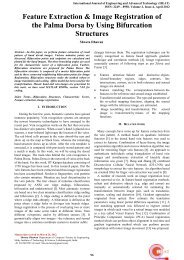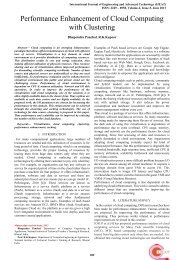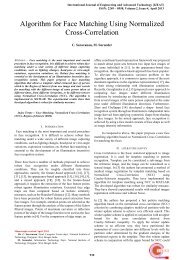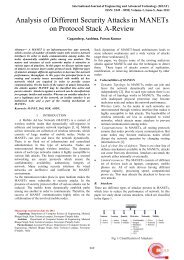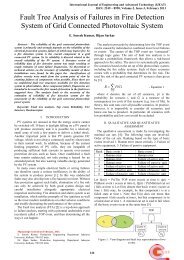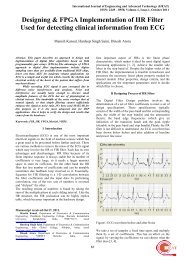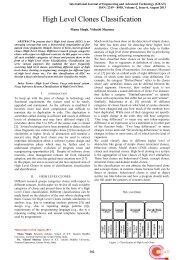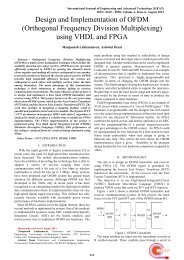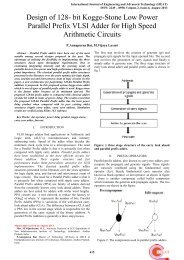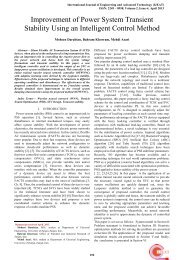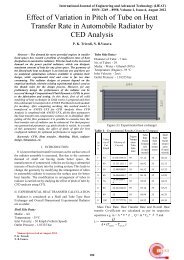Survey on Privacy and Data Security Issues in Cloud Computing
Survey on Privacy and Data Security Issues in Cloud Computing
Survey on Privacy and Data Security Issues in Cloud Computing
You also want an ePaper? Increase the reach of your titles
YUMPU automatically turns print PDFs into web optimized ePapers that Google loves.
Internati<strong>on</strong>al Journal of Eng<strong>in</strong>eer<strong>in</strong>g <strong>and</strong> Advanced Technology (IJEAT)ISSN: 2249 – 8958, Volume-2, Issue-5, June 2013III. SECURITY CONCERNS IN CLOUD COMPUTING<strong>Cloud</strong> services are applicati<strong>on</strong>s runn<strong>in</strong>g somewhere <strong>in</strong> the<strong>Cloud</strong> Comput<strong>in</strong>g <strong>in</strong>frastructures through <strong>in</strong>ternal networkor Internet. For users, they d<strong>on</strong>’t know or care about thedata where to be stored or services where to be provided.<strong>Cloud</strong> comput<strong>in</strong>g allows the providers to develop theapplicati<strong>on</strong>, deploy <strong>and</strong> run, that can easily grow <strong>in</strong> terms ofcapacity or scalability, work rapidly i.e. performance, <strong>and</strong>never or at least rarely fail which means reliability, withoutany c<strong>on</strong>cerns <strong>on</strong> the properties <strong>and</strong> the locati<strong>on</strong>s of theunderly<strong>in</strong>g <strong>in</strong>frastructures. The penalty of obta<strong>in</strong><strong>in</strong>g theseproperties of <strong>Cloud</strong> Comput<strong>in</strong>g are to store <strong>in</strong>dividualprivate data <strong>on</strong> the other side of the Internet <strong>and</strong> get servicefrom other parties (i.e. <strong>Cloud</strong> providers, <strong>Cloud</strong> serviceproviders), <strong>and</strong> c<strong>on</strong>sequently result <strong>in</strong> security <strong>and</strong> privacyissues. Then, what k<strong>in</strong>d of security is sufficient for users?To achieve adequate security, it c<strong>on</strong>ta<strong>in</strong>s 5 goals: They areavailability, data <strong>in</strong>tegrity, c<strong>on</strong>fidentiality, c<strong>on</strong>trol <strong>and</strong> audit.The five goals are <strong>in</strong>tegrated systematically, <strong>and</strong> n<strong>on</strong>e ofthem could be forfeited to achieve the adequate security.Nevertheless, few <strong>Cloud</strong> Comput<strong>in</strong>g systems can achievethe five goals together nowadays[2].A. AvailabilityThe goal of availability for cloud comput<strong>in</strong>g systems<strong>in</strong>clud<strong>in</strong>g applicati<strong>on</strong>s <strong>and</strong> its <strong>in</strong>frastructures is to ensureits users can use them at any time, at any place. <strong>Cloud</strong>comput<strong>in</strong>g system enables its users to access the systemfrom anywhere (e.g., applicati<strong>on</strong>s, services). This is truefor all the <strong>Cloud</strong> Comput<strong>in</strong>g systems (e.g., DaaS, SaaS,PaaS, IaaS, <strong>and</strong> etc.). Required to be accessed at anytime, the <strong>Cloud</strong> Comput<strong>in</strong>g system should be sever<strong>in</strong>gall the time for all the users (say it is scalable for anynumber of users). Two strategies, redundancy <strong>and</strong>harden<strong>in</strong>g, are ma<strong>in</strong>ly used to enhance the availability ofthe <strong>Cloud</strong> system or applicati<strong>on</strong>s hosted <strong>on</strong> it.B. C<strong>on</strong>fidentialityC<strong>on</strong>fidentiality means keep<strong>in</strong>g user’s data secret <strong>in</strong> the<strong>Cloud</strong> systems. The c<strong>on</strong>fidentiality <strong>in</strong> <strong>Cloud</strong> systems isa big obstacle for users to step <strong>in</strong>to it, as many users say“My sensitive corporate data will never be <strong>in</strong> the <strong>Cloud</strong>”<strong>in</strong> the article named “Above the <strong>Cloud</strong>”. <strong>Cloud</strong>Comput<strong>in</strong>g system offer<strong>in</strong>gs are basically publicnetworks. The applicati<strong>on</strong>s or systems are exposed tomore attacks when comparis<strong>on</strong> to those hosted <strong>in</strong> theprivate data centers. Hence, keep<strong>in</strong>g all c<strong>on</strong>fidential dataof user’s secret <strong>in</strong> the cloud is a fundamentalrequirement which will attract even more usersc<strong>on</strong>sequently. Usually, there are two basic approaches(i.e., physical isolati<strong>on</strong> <strong>and</strong> cryptography) to achievesuch c<strong>on</strong>fidentiality, which are broadly adopted by the<strong>Cloud</strong> Comput<strong>in</strong>g vendors. Encrypted storage is anotherchoice to enhance the c<strong>on</strong>fidentiality. For example,encrypt the data before plac<strong>in</strong>g it <strong>in</strong> a cloud. Thisapproach may be even more secure than unencrypteddata <strong>in</strong> a local data center.[7]C. <strong>Data</strong> IntegrityIn the <strong>Cloud</strong> system data <strong>in</strong>tegrity means preserve<strong>in</strong>formati<strong>on</strong> <strong>in</strong>tegrity i.e., not modified or lost unauthorizedusers. The data is the base for provid<strong>in</strong>g <strong>Cloud</strong> Comput<strong>in</strong>gservices, such as Software as a Service, <strong>Data</strong> as a Services,Platform as a Service, keep<strong>in</strong>g data <strong>in</strong>tegrity is a primarytask. <strong>Data</strong> <strong>in</strong>tegrity is fundamental for <strong>Cloud</strong> Comput<strong>in</strong>gsystem, <strong>and</strong> it is expectant to be achieved by techniquessuch as digital signatures, RAID-liked strategies <strong>and</strong> so <strong>on</strong>.D. C<strong>on</strong>trolC<strong>on</strong>trol <strong>in</strong> the <strong>Cloud</strong> system means to regulate the use ofthe system, together with the applicati<strong>on</strong>s, <strong>in</strong>frastructure<strong>and</strong> the data. <strong>Cloud</strong> comput<strong>in</strong>g system at all times <strong>in</strong>volvesdistributed computati<strong>on</strong> <strong>on</strong> multiple large-scale data setsacross a large number of computer nodes. Every <strong>in</strong>ternetuser is able to c<strong>on</strong>tribute his or her <strong>in</strong>dividual data to the<strong>Cloud</strong> Computer systems which are situated <strong>on</strong> the otherside of the Internet, <strong>and</strong> utilize them. For <strong>in</strong>stance, a user’sclick stream across a set of webs (e.g., Google search webpages, Amaz<strong>on</strong> book store, etc.) can be used to presenttargeted advertis<strong>in</strong>g. Future healthcare applicati<strong>on</strong>s mightuse an <strong>in</strong>dividual’s DNA sequence (which is captured byhospitals) to develop tailored drugs <strong>and</strong> other pers<strong>on</strong>alizedmedical treatments. When all these private data are stored <strong>in</strong>the <strong>Cloud</strong> Comput<strong>in</strong>g system envir<strong>on</strong>ment, users of <strong>Cloud</strong>Comput<strong>in</strong>g systems might face many threats to their<strong>in</strong>dividual data[6].E. AuditAudit means to watch what happened <strong>in</strong> the <strong>Cloud</strong> system.Auditability can be added as an additi<strong>on</strong>al layer above thevirtualized operati<strong>on</strong> system or virtualized applicati<strong>on</strong>envir<strong>on</strong>ment hosted <strong>on</strong> the virtual mach<strong>in</strong>e to providefacilities watch<strong>in</strong>g what happened <strong>in</strong> the system. It is moresecure than that which is built <strong>in</strong>to the applicati<strong>on</strong>s or <strong>in</strong>tothe software themselves, because it is able to watch theentire access durati<strong>on</strong>. For such k<strong>in</strong>d of scenarios, threema<strong>in</strong> attributes should be audited:1. Events: The state changes <strong>and</strong> other factors thataffected the system availability.2. Logs: Comprehensive <strong>in</strong>formati<strong>on</strong> about users’applicati<strong>on</strong> <strong>and</strong> its runtime envir<strong>on</strong>ment.3. M<strong>on</strong>itor<strong>in</strong>g: Should not be <strong>in</strong>trusive <strong>and</strong> must belimited to what the <strong>Cloud</strong> provider reas<strong>on</strong>ably needs <strong>in</strong>order to run their facility.IV. THREATS TO SECURITY IN CLOUD COMPUTING<strong>Cloud</strong> comput<strong>in</strong>g may not <strong>in</strong>crease the risk that pers<strong>on</strong>al<strong>in</strong>formati<strong>on</strong> will be improperly exposed or misused; it could<strong>in</strong>crease the chances of exposure. The aggregati<strong>on</strong> of data <strong>in</strong>a cloud provider can make that data very attractive tocybercrim<strong>in</strong>als. Additi<strong>on</strong>ally, given how <strong>in</strong>expensive it is tokeep data <strong>in</strong> the cloud, there may be a tendency to reta<strong>in</strong> itfor an <strong>in</strong>def<strong>in</strong>ite period, thereby <strong>in</strong>creas<strong>in</strong>g the risk ofbreaches.The chief c<strong>on</strong>cern <strong>in</strong> cloud envir<strong>on</strong>ments is to providesecurity around multi-tenancy <strong>and</strong> isolati<strong>on</strong>; giv<strong>in</strong>gcustomers more comfort <strong>in</strong> additi<strong>on</strong> “trust us” idea ofclouds. <strong>Security</strong> at different levels such as Host level,Network level <strong>and</strong> Applicati<strong>on</strong> level is necessary to keepthe cloud up <strong>and</strong> runn<strong>in</strong>g c<strong>on</strong>t<strong>in</strong>uously.A. Basic <strong>Security</strong>Web 2.0, a key technology towards enabl<strong>in</strong>g the use ofSoftware as a Service relieves the users from tasks like<strong>in</strong>stallati<strong>on</strong> <strong>and</strong> ma<strong>in</strong>tenance of software. It’s widely usedall over. The security has become more important than everfor such envir<strong>on</strong>ment, as the user community us<strong>in</strong>g Web 2.0is ris<strong>in</strong>g.SQL <strong>in</strong>jecti<strong>on</strong> attacks: are the <strong>on</strong>e <strong>in</strong> which a maliciouscode is <strong>in</strong>serted <strong>in</strong>to a st<strong>and</strong>ard SQL code <strong>and</strong> thus the131



